by Susan Flantzer
© Unofficial Royalty 2019

The Royal Chapel of Granda; Credit – By Heparina1985 – Own work, CC BY-SA 4.0, https://commons.wikimedia.org/w/index.php?curid=71236047
The House of Trastámara was a royal dynasty in Spain which first ruled in Castile and expanded into Aragon, Navarre, and Naples.
The House of Trastámara reigned in:
- Kingdom of Castile from 1369 – 1555
- Kingdom Aragon from 1412 – 1555
- Kingdom of Navarre from 1425 – 1479
- Kingdom of Naples from 1458 – 1501 and from 1504 – 1555
The marriage of King Ferdinand (Fernando) II of Aragon (reigned 1479 – 1516) and Queen Isabella (Isabel) I of Castile (reigned 1474 – 1504) ultimately led to the political unification of Aragon and Castile into the Kingdom of Spain under their grandson Charles (Carlos) I, King of Spain who later also became Charles V, Holy Roman Empire. Ferdinand and Isabella and their five children will be covered in this article.
********************
The Royal Chapel of Granada (Capilla Real de Granada)

Royal Chapel of Granada in 1850, drawing by Francesc Xavier Parceris; Credit – Wikipedia
Ferdinand and Isabella along with their daughter and heir Joanna (Juana) I, Queen of Castile and Aragon and her husband Philip, Duke of Burgundy are buried at the Royal Chapel of Granada in Granada, presently the capital city of the province of Granada, in the autonomous community of Andalusia in southern Spain. Also buried at the Royal Chapel is Miguel da Paz, Crown Prince of both Portugal and Spain, the only child of Ferdinand and Isabella’s eldest child, also named Isabella, and King Manuel I of Portugal. Miguel da Paz’s mother died delivering him and he died shortly before his second birthday. Had he lived, Miguel de Paz most likely would have ruled over a united Spain and Portugal. The Royal Chapel was built between 1505 and 1517 and was dedicated to St. John the Baptist and St. John the Evangelist.
********************
All portraits and photos are from Wikipedia unless otherwise noted.
Ferdinand II, King of Aragon, reigned January 20, 1479 – January 23, 1516

Born March 10, 1452, at Sada Palace in Sos, Kingdom of Aragon, Ferdinand was the son of King John II of Aragon and his second wife Juana Enríquez de Córdoba, 5th Lady of Casarrubios del Monte, a Castilian noblewoman. On October 19, 1469, in the Palacio de los Vivero in Valladolid, Kingdom of Castile, Ferdinand married Infanta Isabella, the half-sister and heir of King Enrique IV of Castile.
Ferdinand became jure uxoris (by the right of his wife) King of Castile when Isabella succeeded her brother in 1474. When Ferdinand succeeded his father as King of Aragon in 1479, the Crown of Castile and the various territories of the Crown of Aragon were united in a personal union.
Isabella died in 1504. Two years later, Ferdinand married Germaine of Foix, the granddaughter of his half-sister Queen Eleanor of Navarre and the niece of King Louis XII of France. Ferdinand and Germaine had one son Juan, Prince of Girona, who died shortly after his birth. Had he survived, the crown of Aragon would have been separated from the crown of Castile.
Ferdinand was ill with dropsy, now called edema, which is a symptom of various diseases of the heart, kidneys, and digestive tract. He died at the age of 63 on January 23, 1516, in Madrigalejo, Extremadura, Kingdom of Castile and was buried next to his first wife Isabella at the Royal Chapel of Granada.
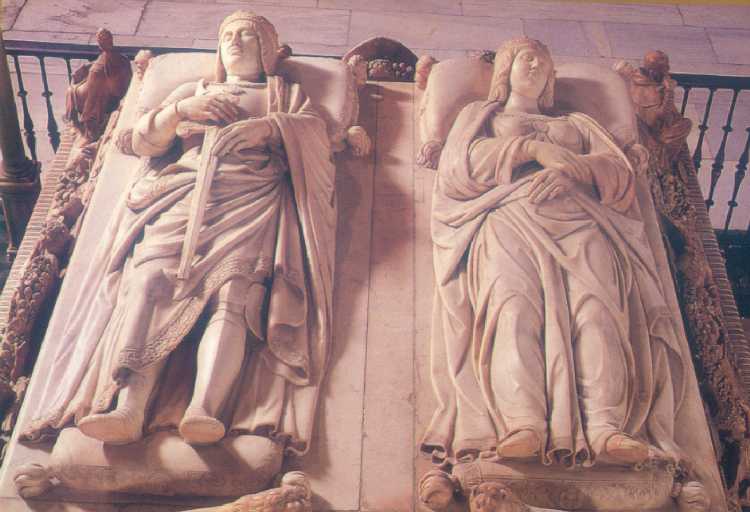
Tomb of Ferdinand and Isabella; Credit – By Javi Guerra Hernando – Own work, CC BY-SA 4.0, https://commons.wikimedia.org/w/index.php?curid=35974697
********************
Isabella I, Queen of Castile, reigned December 11, 1474 – November 26, 1504
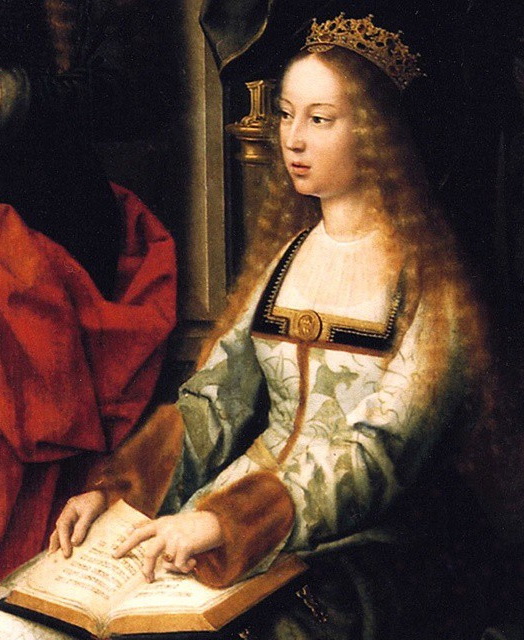
Isabella was born on April 22, 1451, at Madrigal de las Altas Torres, Ávila, the Kingdom of Castile in the palace which is now the Monastery of Our Lady of Grace. She was the daughter of King Juan II of Castile and his second wife Isabella of Portugal. Isabella and her half-brother Enrique, from her father’s first marriage, were the only children of Juan II to survive childhood. Enrique was twenty-six years older than Isabella. His first marriage was childless and the children of his second wife were not considered his, so upon his death in 1474, Enrique’s half-sister became Isabella I, Queen of Castile.
According to the prenuptial agreement signed at the time of her marriage to the future Ferdinand II, King of Aragon, the couple would share their power. Ferdinand became jure uxoris (by the right of his wife) King of Castile when Isabella succeeded her brother. When Ferdinand succeeded his father as King of Aragon in 1479, the Crown of Castile and the various territories of the Crown of Aragon were united in a personal union.
Isabella’s health had been in decline since the death of her only son Juan, Prince of Asturias in 1497. In the fall of 1504, she became quite ill and officially withdrew from governmental affairs. On November 26, 1504, Isabella died at the age of 53 at the Royal Palace in Medina del Campo, Valladolid, Kingdom of Castile.
In her will, Isabella requested a simple burial at the monastery of San Francisco in the Alhambra royal complex in Granada. She also further stated that she “wanted and commanded” that if Ferdinand “chooses to buried in any church or monastery of any other part or place of my kingdoms, that my body be moved there and buried together.”
Isabella was first buried, in accordance with her wishes, at the monastery of San Francisco in the Alhambra royal complex in Granada. Her remains were later transferred to the Royal Chapel of Granada which was built after her death and now rest with the remains of Ferdinand as she wished.

The coffins of Ferdinand and Isabella resting together in the crypt at the Royal Chapel of Granada; Credit – By Immasureda – Own work, CC BY-SA 3.0 es, https://commons.wikimedia.org/w/index.php?curid=35340150
********************
Isabella of Aragon, Queen of Portugal
Princess of Asturias and Heir Presumptive of King Ferdinand II of Aragon and Queen Isabella I of Castile

Isabella was born on October 2, 1470, at the Palace of the Counts of Buendía in Dueñas, Palencia in the Kingdom of Castile. She was the eldest child of King Ferdinand II of Aragon and Queen Isabella I of Castile. In 1490, Isabella married Prince Afonso of Portugal, the only son and heir of King João II of Portugal, but Afonso died a year later in a horse-riding accident.
In September 1497, Isabella married her first husband’s uncle King Manuel I of Portugal. A month later, Isabella’s only brother Juan, Prince of Asturias died and she became Princess of Asturias and heir presumptive to her parents’ thrones. On August 23, 1498, at the Archbishop’s Palace of Zaragoza in the Kingdom of Aragon, Isabella gave birth to her only child, Miguel da Paz, Prince of Portugal but she died within an hour of her son’s birth. Her son was later recognized as heir apparent to the thrones of Portugal, Castile, and Aragon but he died a month before his second birthday.
Before she died, Isabella requested to be dressed as a nun and to be buried at the Convent of Santa Isabel in Toledo, then in the Kingdom of Castile. Before her death in 1504, Queen Isabella I of Castile requested that her daughter’s remains be transferred to her burial site but this was never done.
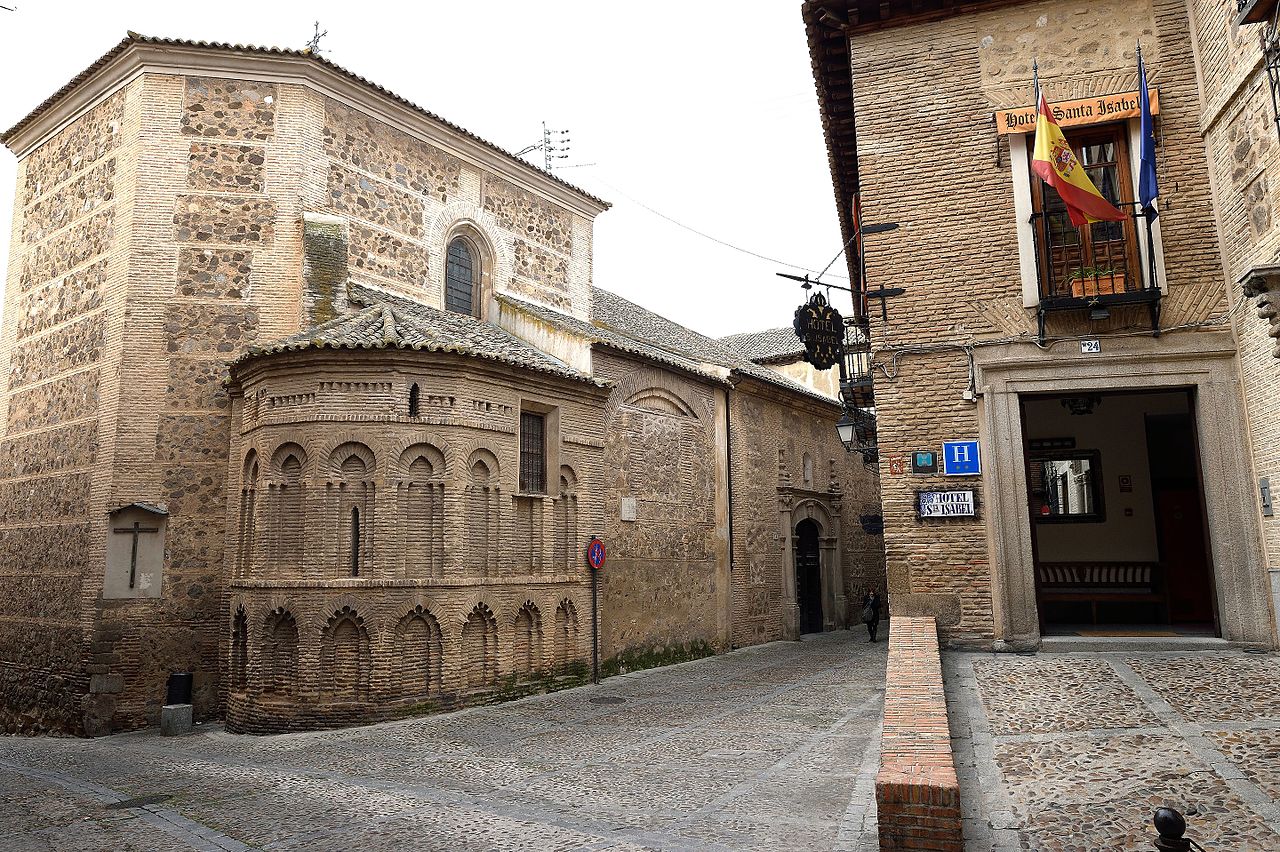
Convent of Santa Isabel in Toledo, Spain on the left; Credit – De Tim Adams – Trabajo propio, CC BY 3.0, https://commons.wikimedia.org/w/index.php?curid=55487135
********************
Juan of Aragon, Prince of Asturias
![]()
Born on June 30, 1478, Juan was the only son of King Ferdinand II of Aragon and Queen Isabella I of Castile. He was Prince of Asturias and the heir apparent to his parents’ thrones.
Ferdinand and Isabella cemented an alliance with Maximilian I, Holy Roman Emperor with a double marriage of their children. Juan would marry Maximilian’s only daughter Archduchess Margaret of Austria and Joanna would marry the emperor’s only son and heir Archduke Philip of Austria. On April 3, 1497, Juan and Margaret were married at the Cathedral of Saint Mary of Burgos in Burgos in the Kingdom of Castile.
Six months later, while on the way home from his eldest sister’s wedding in Portugal, Juan died at the age of 19 on October 4, 1497, in Salamanca in the Kingdom of Castile. It is probable that the cause of Juan’s death was tuberculosis. Juan was buried in a beautiful tomb at the Royal Monastery of Santo Tomás in Ávila, Kingdom of Castile. Two months later, on December 8, 1497, Margaret gave birth to a premature, stillborn girl.
- Wikipedia: Royal Monastery of Santo Tomás (in Spanish)
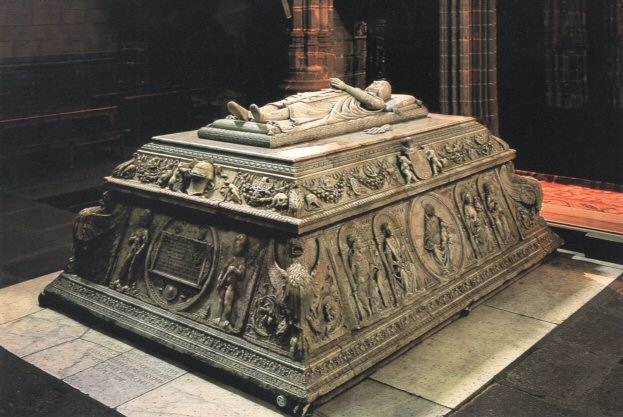
Tomb of Juan of Aragon, Prince of Asturias; Credit – De Mrabulense – Trabajo propio, Dominio público, https://commons.wikimedia.org/w/index.php?curid=11273733
********************
Juana, Queen of Castile, reigned 1504 – 1555, Queen of Aragon, reigned 1516 – 1555
Juana was born in Toledo in the Kingdom of Castile on November 6, 1479. She had an elder sister who had one son and a childless elder brother but because of the deaths of her two elder siblings and her nephew, Juana turned out to be the heir to her parents’ thrones.
On October 20, 1496, at the Collegiate Church of San Gumaro in Lier, Flanders, now in Belgium, Juana married Philip of Habsburg, Duke of Burgundy, also known as Philip the Handsome. Philip was the only son of Maximilian I, Holy Roman Emperor and Mary, Duchess of Burgundy in her own right. Juana and Philip had four daughters and two sons. All the daughters became Queen Consorts, one son became a King and one son became a King and an Emperor.
Juana succeeded to the throne of Castile upon her mother’s death in 1504. After her husband Philip died suddenly in 1506, her father Ferdinand made her out to be mentally unstable and confined in the Royal Palace in Tordesillas, near Valladolid in the Kingdom of Castile. Ferdinand then ruled Castile. After Ferdinand’s death in 1516, Juana’s son Charles (Carlos) was proclaimed King of Castile and Aragon jointly with his mother. Charles continued to hold Juana at the Royal Palace in Tordesillas for the rest of her life. Of course, being confined took a toll on her physical and mental health. However, the claims of Juana’s “madness” as rumored during her lifetime remain controversial among historians. Juana died on April 12, 1555, at the age of 75 at the Royal Palace at Tordesillas. She was buried at the Royal Chapel of Granada with her husband and her parents.
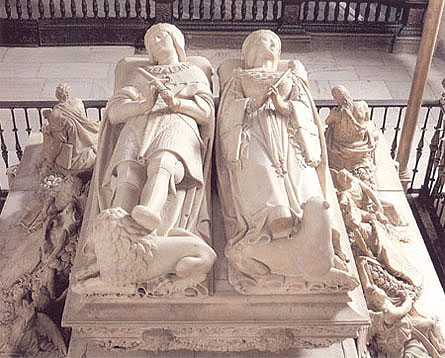
Tomb of Juana and Philip; Credit – By Javi Guerra Hernando – Own work, CC BY-SA 4.0, https://commons.wikimedia.org/w/index.php?curid=35974698
********************
Philip of Habsburg, Duke of Burgundy, King of Castile

Philip was born in Bruges, then in the County of Flanders, now in Belgium, on July 22, 1478. He was the only son of Maximilian I, Holy Roman Emperor and Mary, Duchess of Burgundy in her own right. Philip’s mother died when he was four years old and he inherited the Duchy of Burgundy and the Burgundian Netherlands which included large parts of present-day Belgium and the Netherlands, as well as Luxembourg and parts of northern France. When his wife Juana succeeded her mother as Queen of Castile in 1504, Philip became jure uxoris (by the right of his wife) King Philip I of Castile.
On September 16, 1506, Philip was at the Casa del Cordón in Burgos, Kingdom of Castile, enjoying some outdoor activity on a rather cool day. The following day, he felt discomfort and had a high fever that continued over the following days. Philip died in the early hours of September 24-25, 1506, at the age of 28. His death was so sudden that the rumors spread that he had been poisoned. Juana certainly believed poisoning to be the cause of Philip’s death. However, it is more likely that Philip died of typhoid fever. Supposedly, because of her suspicions of poisoning, Juana refused to allow Philip’s body to be buried or to be parted from it for quite a while. Eventually, Philip was buried at the Royal Chapel of Granada.
Because Philip died before his father, he never inherited his father’s territories or became Holy Roman Emperor. However, his son Charles (Carlos) became the first king of a unified Spain as Charles (Carlos) I and Holy Roman Emperor as Charles V. As Head of the House of Habsburg, Charles’ territories included the Holy Roman Empire extending from Germany to northern Italy, the Burgundian Netherlands, Austria, Spain and its possessions in the New World and southern Italian kingdoms of Naples, Sicily, and Sardinia. Much of these territories became a legacy for many Habsburgs over the next centuries.

Tomb of Philip and Joanna on the left and the tomb of Ferdinand and IsaBy Javi Guerra Hernando – Own work, CC BY-SA 4.0, https://commons.wikimedia.org/w/index.php?curid=35974695bella on the right; Credit-
********************
Maria of Aragon, Queen of Portugal
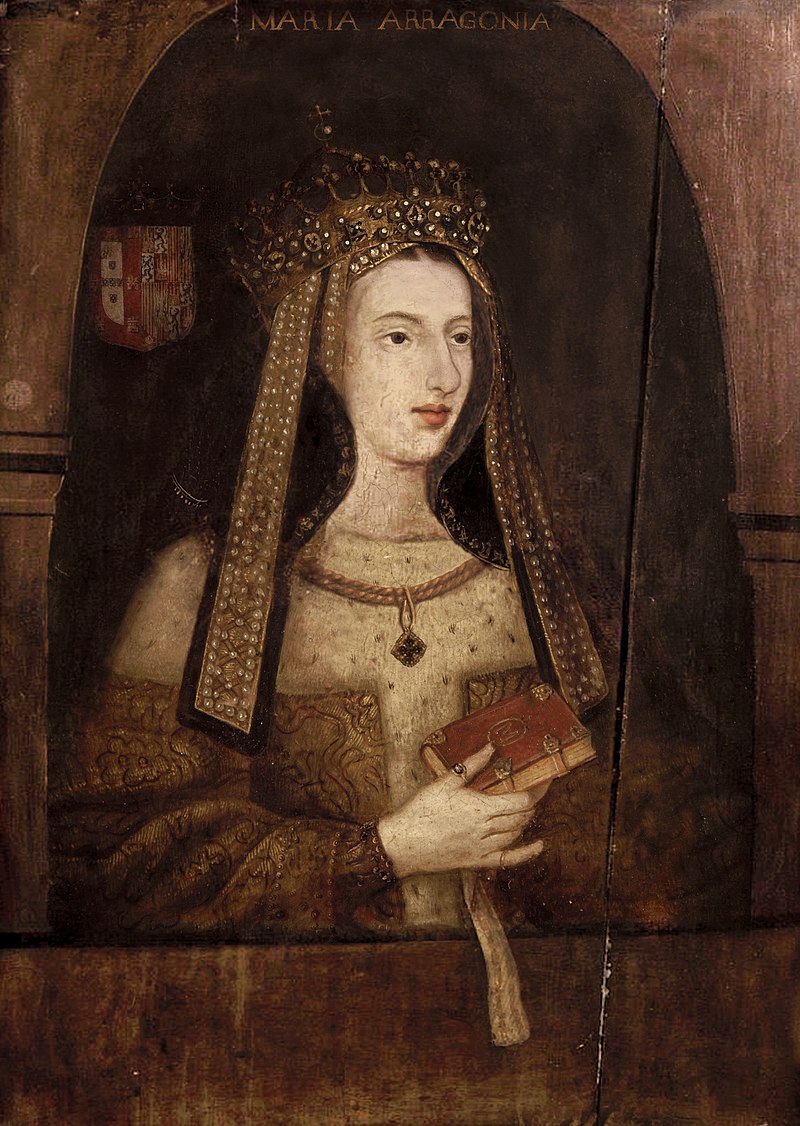
Maria was born at the Alcázar de los Reyes Cristianos (Castle of the Christian Monarchs) in Córdoba in the Kingdom of Castile on June 29, 1482. She was the second youngest child of King Ferdinand II of Aragon and Queen Isabella I of Castile.
Maria’s eldest sister Isabella had married King Manuel I of Portugal. When Isabella died in childbirth, Maria’s parents wanted to keep the dynastic links with Portugal and so it was decided that Maria would marry her sister’s widower. The marriage was held at Alcácer do Sal in Portugal on October 30, 1500.
Maria and Manuel had ten children and eight survived to adulthood. Among their children were two Kings of Portugal, King João III and Cardinal-King Henrique I, and Isabella who married her first cousin King Charles (Carlos) I of Spain/Charles V, Holy Roman Emperor. Isabella and Charles were the parents of King Philip II of Spain.
Having ten pregnancies took a toll on Maria and her last pregnancy ultimately did her in. On September 9, 1516, Maria gave birth to her last child, a son, who died at birth. She never recovered from the birth and died on March 7, 1517, at the age of 34. Initially, Maria was buried at the Convent of the Mother of God in Lisbon, Kingdom of Portugal. Her remains were later transferred to the Jerónimos Monastery of Santa María de Belém in Lisbon which she founded with her husband to commemorate the safe return of explorer Vasco de Gama from his voyage to India. In an Indian motif, the tombs of Maria and Manuel rest on marble elephants.

Tombs of King Manuel I and Queen Maria; Credit – By Georges Jansoone – Self-photographed, CC BY 2.5, https://commons.wikimedia.org/w/index.php?curid=1336320
*******************
Catherine (Catalina) of Aragon, Queen of England

The youngest child of Queen Isabella I of Castile and King Ferdinand II of Aragon, Catherine was born at the Archbishop’s Palace of Alcalá de Henares near Madrid in the Kingdom of Castile on December 16, 1485.
Catherine first was married to Arthur, Prince of Wales, and then to his younger brother, King Henry VIII of England, sons of King Henry VII of England. Catherine was the mother of Queen Mary I of England. Her inability to bear a male heir caused Henry to seek a divorce from her in 1533. Following her divorce, broken and humiliated, Catherine died at Kimbolton Castle on January 7, 1536. Rumors were circulated that she had been poisoned. Her embalmer described her heart as “quite black and hideous to look at” with a “black round body stuck to the outside.” Modern doctors suspect that her heart’s discoloration was due to cancer.
Catherine was buried at Peterborough Cathedral on January 29, 1536, but her daughter Mary was not allowed to attend her funeral. A cortege from Kimbolton Castle brought Catherine’s remains to Peterborough Abbey, now Peterborough Cathedral. It was the nearest great religious place and Henry did not want to move her remains to London as it would have given the wrong message. The cortege was covered in black velvet, pulled by six horses, and accompanied by 50 servants in suits made of black fabric, carrying banners and torches. The cortege was met by four bishops and six abbots, and 1,000 candles lit up the abbey, where three masses were held as part of the funeral.
Catherine was buried in an elaborate black marble tomb gilded with gold. The gold was stolen by Oliver Cromwell’s soldiers during the English Civil War. The marble tomb survived into the 18th century when it was taken apart by one of the deans of the cathedral for the floor of his summer house. In 1895, Katharine Clayton, the wife of one of the canons at the cathedral, decided something should be done to restore Catherine’s tomb, so she launched an appeal for Katharines/Katherines/Catherines around England to donate money towards the project. Every year around the anniversary of her death, a service commemorating Catherine of Aragon’s life is held at Peterborough Cathedral. Catherine’s grave is visited by many people each year, some of who leave flowers and pomegranates, Catherine’s heraldic symbol.
********************
This article is the intellectual property of Unofficial Royalty and is NOT TO BE COPIED, EDITED, OR POSTED IN ANY FORM ON ANOTHER WEBSITE under any circumstances. It is permissible to use a link that directs to Unofficial Royalty.


